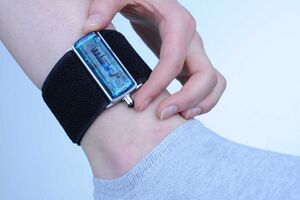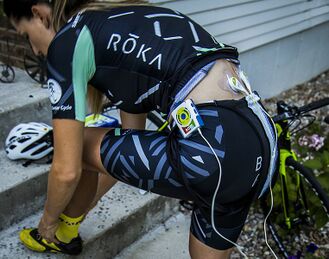Accelerometers in Rehabilitation
Original Editor - Ananya Bunglae Sudindar
Top Contributors - Ananya Bunglae Sudindar
Introduction[edit | edit source]
Wearable devices, also known as wearables, are instruments that have garnered significant attention for enabling non-invasive, real-time monitoring of physical and physiological parameters in smart care and digital medicine. These devices are worn on the body and provide physiological measures directly to smart devices, offering valuable insights into health metrics. [1][2][3]
Accelerometers are wearable devices designed to measure the acceleration of the body segment to which they are attached[4]. These devices play a crucial role in studying human movement across various applications, including activity detection, assessing postural balance, evaluating sports physical function, and investigating falls. They operate based on Newton’s law of motion wherein they measure linear acceleration which represents the change in an object’s speed over time. [5]
Application in Rehabilitation[edit | edit source]
Gait Analysis[edit | edit source]
Gait analysis using accelerometers often involves placing sensors at various body segments in order to capture the spatiotemporal parameters of an individual's gait pattern. The collected data are then analyzed for clinical applications, disease-specific insights, and rehabilitation monitoring, providing valuable information for healthcare professionals and researchers.
Sensor Placement[edit | edit source]
- Accelerometers are strategically placed on different body parts, such as ears, thighs, pelvis, feet, and others, depending on the specific conditions and objectives of the evaluation.
- Multiple sensors may be used simultaneously to obtain comprehensive data about the entire body's movement.
- The accelerometers record the accelerations and decelerations of body segments during the gait cycle.
- Accelerometers such as triaxial accelerometers capture movement in three dimensions, providing detailed information about motion in the frontal, sagittal, and transverse planes
- The collected data are utilized to assess specific aspects of gait, such as symmetry, balance, stride length, step frequency, and temporal parameters.
Clinical Use[edit | edit source]
- Gait analysis using accelerometers is applied across various clinical conditions, including orthopaedic and neurological conditions.
- Gait analysis is tailored to the characteristics of specific diseases or conditions, such as Parkinson's disease, Huntington's disease, Cerebral Palsy, Orthopaedic injuries, and more.
- For example, in Parkinson's disease, gait analysis may focus on detecting freezing of gait (FoG) and other abnormalities.
- Accelerometers can be used to monitor the rehabilitation progress of patients by tracking the changes in gait patterns over time. It can also be used to assess the effectiveness of rehabilitation programmes.
Monitoring Physical Activity Levels[edit | edit source]
Physical activity (PA) plays a crucial role in maintaining the health and well-being of individuals. In recent years, accelerometers have emerged as essential tools for assessing PA. These devices are integral to clinical practice and contribute significantly to evaluating PA levels and monitoring treatment progress in individuals with chronic diseases. [7][8]
Sensor Placement[edit | edit source]
The choice of accelerometer placement is subjective and depends on various factors such as the targeted activities and the consideration of participant burden. The most common sensor placements to measure physical activity include:
- Wrist: It is the most popular choice of location for placing accelerometers but has accuracy limitations across various activities.
- Hip: Hip placement is considered to be the most reliable location due to its high accuracy while evaluating different kinds of activities.
- Ankle: Placing the sensor at the ankle is often beneficial for faster activities but should be used with caution while evaluating slower activities.
- Thigh: Sensors placed on the thigh show good performance across various activities.
Clinical Use[edit | edit source]
- Accelerometers play an important role in monitoring the physical activity of high-risk populations with the aim of identifying sedentary behaviours that may result in various disease states, including but not limited to stroke and cancer.[11][12]
- Accelerometers are used to oversee physical activity in the elderly demographic, contributing to the development and evaluation of interventions aimed at reducing prolonged sitting periods. [13]
- Furthermore, this technology can be harnessed to monitor cardiometabolic health in individuals by means of tracking their physical activity. [14]
Other Applications[edit | edit source]
- Postural evaluation
- Balance training
- Fall prevention
Advantages of Accelerometers[edit | edit source]
- Accelerometer-derived measures can be incorporated during patient assessments in situations where patients frequently struggle to complete standard questionnaire-based tools, administered on an intermittent basis. [15]
- Accelerometers can be used for remote monitoring of patients which plays a significant role in improved patient outcomes and participation in research studies. It can be used to perform certain assessments such as the Timed Up and Go (TUG) which may allow clinicians to make decisions about treatment without necessarily seeing the patient in a clinic.[15][16][17]
- Accelerometers can be used in telehealth to monitor patients physical activity level. [18]
Challenges of Using Accelerometers in Rehabilitation[edit | edit source]
- Drift or change: Over time, the internal mechanical or electrical components of accelerometers may experience changes, resulting in bias or offset in the readings. This drift can affect the reliability of the measurements.
- Sensitivity of accelerometers: The sensitivity of accelerometers can lead to the amplification of microscopic mechanical motions, introducing noise into the readings. This noise can interfere with the precision of the accelerometer's measurements.
- Effects of gravity: The gravitational force of the earth is projected along the sensitivity axes, creating a confounding effect on movements along these axes. Understanding and accounting for this gravitational influence often poses a challenge in clinical practice.
References[edit | edit source]
- ↑ Miller DJ, Sargent C, Roach GD. A validation of six wearable devices for estimating sleep, heart rate and heart rate variability in healthy adults. Sensors. 2022 Aug 22;22(16):6317.
- ↑ Lu L, Zhang J, Xie Y, Gao F, Xu S, Wu X, Ye Z. Wearable health devices in health care: narrative systematic review. JMIR mHealth and uHealth. 2020 Nov 9;8(11):e18907.
- ↑ Lin WY, Chen CH, Lee MY. Design and implementation of a wearable accelerometer-based motion/tilt sensing internet of things module and its application to bed fall prevention. Biosensors. 2021 Oct 29;11(11):428.
- ↑ Migueles JH, Cadenas-Sanchez C, Ekelund U, Delisle Nyström C, Mora-Gonzalez J, Löf M, Labayen I, Ruiz JR, Ortega FB. Accelerometer data collection and processing criteria to assess physical activity and other outcomes: a systematic review and practical considerations. Sports medicine. 2017 Sep;47:1821-45.
- ↑ Celik Y, Vitorio R, Powell D, Moore J, Young F, Coulby G, Tung J, Nouredanesh M, Ellis R, Izmailova ES, Stuart S. Sensor Integration for Gait Analysis.
- ↑ 6.0 6.1 6.2 Jarchi D, Pope J, Lee TK, Tamjidi L, Mirzaei A, Sanei S. A review on accelerometry-based gait analysis and emerging clinical applications. IEEE reviews in biomedical engineering. 2018 Feb 16;11:177-94.
- ↑ Allahbakhshi H, Hinrichs T, Huang H, Weibel R. The key factors in physical activity type detection using real-life data: A systematic review. Frontiers in physiology. 2019 Feb 12;10:75
- ↑ Davoudi A, Mardini MT, Nelson D, Albinali F, Ranka S, Rashidi P, Manini TM. The effect of sensor placement and number on physical activity recognition and energy expenditure estimation in older adults: Validation study. JMIR mHealth and uHealth. 2021 May 3;9(5):e23681.
- ↑ Davoudi A, Mardini MT, Nelson D, Albinali F, Ranka S, Rashidi P, Manini TM. The effect of sensor placement and number on physical activity recognition and energy expenditure estimation in older adults: Validation study. JMIR mHealth and uHealth. 2021 May 3;9(5):e23681.
- ↑ Marshall MR, Montoye AH, Conway MR, Schlaff RA, Pfeiffer KA, Pivarnik JM. Location, Location, Location: Accelerometer Placement Affects Steps-Based Physical Activity Outcomes During Pregnancy and Postpartum. American Journal of Lifestyle Medicine. 2023 Jan;17(1):123-30.
- ↑ Hooker SP, Diaz KM, Blair SN, Colabianchi N, Hutto B, McDonnell MN, Vena JE, Howard VJ. Association of accelerometer-measured sedentary time and physical activity with risk of stroke among US adults. JAMA Network Open. 2022 Jun 1;5(6):e2215385-.
- ↑ Parada Jr H, McDonald E, Bellettiere J, Evenson KR, LaMonte MJ, LaCroix AZ. Associations of accelerometer-measured physical activity and physical activity-related cancer incidence in older women: results from the WHI OPACH Study. British Journal of Cancer. 2020 Apr 28;122(9):1409-16.
- ↑ Giné-Garriga M, Sansano-Nadal O, Tully MA, Caserotti P, Coll-Planas L, Rothenbacher D, Dallmeier D, Denkinger M, Wilson JJ, Martin-Borràs C, Skjødt M. Accelerometer-measured sedentary and physical activity time and their correlates in European older adults: the SITLESS study. The Journals of Gerontology: Series A. 2020 Sep 1;75(9):1754-62.
- ↑ Whitaker KM, Pettee Gabriel K, Buman MP, Pereira MA, Jacobs Jr DR, Reis JP, Gibbs BB, Carnethon MR, Staudenmayer J, Sidney S, Sternfeld B. Associations of accelerometer‐measured sedentary time and physical activity with prospectively assessed cardiometabolic risk factors: the CARDIA study. Journal of the American Heart Association. 2019 Jan 8;8(1):e010212.
- ↑ 15.0 15.1 Ó Breasail M, Biswas B, Smith MD, Mazhar MK, Tenison E, Cullen A, Lithander FE, Roudaut A, Henderson EJ. Wearable GPS and accelerometer technologies for monitoring mobility and physical activity in neurodegenerative disorders: A systematic review. Sensors. 2021 Dec 10;21(24):8261.
- ↑ van Eijk RP, Bakers JN, Bunte TM, de Fockert AJ, Eijkemans MJ, van den Berg LH. Accelerometry for remote monitoring of physical activity in amyotrophic lateral sclerosis: a longitudinal cohort study. Journal of neurology. 2019 Oct;266:2387-95.
- ↑ Del Din S, Kirk C, Yarnall AJ, Rochester L, Hausdorff JM. Body-worn sensors for remote monitoring of Parkinson’s disease motor symptoms: vision, state of the art, and challenges ahead. Journal of Parkinson's disease. 2021 Jan 1;11(s1):S35-47.
- ↑ Kline PW, Melanson EL, Sullivan WJ, Blatchford PJ, Miller MJ, Stevens-Lapsley JE, Christiansen CL. Improving physical activity through adjunct telerehabilitation following total knee arthroplasty: randomized controlled trial protocol. Physical therapy. 2019 Jan;99(1):37-45.








